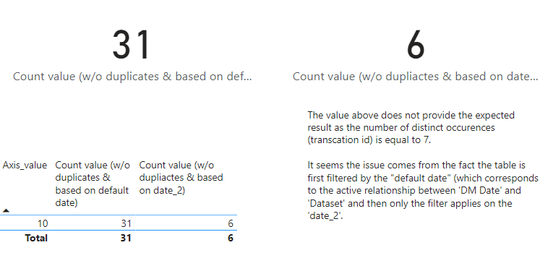- Power BI forums
- Updates
- News & Announcements
- Get Help with Power BI
- Desktop
- Service
- Report Server
- Power Query
- Mobile Apps
- Developer
- DAX Commands and Tips
- Custom Visuals Development Discussion
- Health and Life Sciences
- Power BI Spanish forums
- Translated Spanish Desktop
- Power Platform Integration - Better Together!
- Power Platform Integrations (Read-only)
- Power Platform and Dynamics 365 Integrations (Read-only)
- Training and Consulting
- Instructor Led Training
- Dashboard in a Day for Women, by Women
- Galleries
- Community Connections & How-To Videos
- COVID-19 Data Stories Gallery
- Themes Gallery
- Data Stories Gallery
- R Script Showcase
- Webinars and Video Gallery
- Quick Measures Gallery
- 2021 MSBizAppsSummit Gallery
- 2020 MSBizAppsSummit Gallery
- 2019 MSBizAppsSummit Gallery
- Events
- Ideas
- Custom Visuals Ideas
- Issues
- Issues
- Events
- Upcoming Events
- Community Blog
- Power BI Community Blog
- Custom Visuals Community Blog
- Community Support
- Community Accounts & Registration
- Using the Community
- Community Feedback
Register now to learn Fabric in free live sessions led by the best Microsoft experts. From Apr 16 to May 9, in English and Spanish.
- Power BI forums
- Forums
- Get Help with Power BI
- Desktop
- Countx within context transition
- Subscribe to RSS Feed
- Mark Topic as New
- Mark Topic as Read
- Float this Topic for Current User
- Bookmark
- Subscribe
- Printer Friendly Page
- Mark as New
- Bookmark
- Subscribe
- Mute
- Subscribe to RSS Feed
- Permalink
- Report Inappropriate Content
Countx within context transition
Hi All,
I am struggling with a context transition problem.
I have preapared a simple data model to illustrate it.
I have:
- 1 transaction table with values that I need to aggregate (in this table there are transactions id with duplicates)
- 1 date table with an active relationship (date_1) and an inactive relationship (date_2)
- 1 table with a list of values (from 1 to 500+) which will be used as an axis (an inactive relationship has been created between the transaction table and this table.
I want to count the number of occurences (values in the transcation table) and display the number of occurences on a bar chart using the 3rd table as axis.
The challenge is:
1/ to ignore duplicates
2/ to apply the right filter context (date_2 instead of date_1)
The problem I have is that my measure first applies a filter on date_1 and only then on date_2.
In the attached pbix, my measure is the following ("Count value (w/o dupliactes & based on date_2)". With the current filters on the report page the result should be 7 and not 6. One of the transactions is not taken into account because the "date_1" of this transcation is <> 2020.
How can I remove the filter context on date_1 and apply it on date_2 only? Please take a look at the attached file because the measure also use TREATAS to link the values from the transcation table and the axis table which makes the scenario a bit more complex.
Thanks in advance for your help.
Solved! Go to Solution.
- Mark as New
- Bookmark
- Subscribe
- Mute
- Subscribe to RSS Feed
- Permalink
- Report Inappropriate Content
Hi @lbendlin , you are right. I have found the answer myself and updated the pbix. I just didn't had time to update the post here. 😉
Now I am trying to develop the logic further and get the cumulated value (using ALLSELECTED). I have not succeeded yet, but I will post a complete answer if I mange to get the expected result. If you have any idea on how to achieve this it will be welcome.
- Mark as New
- Bookmark
- Subscribe
- Mute
- Subscribe to RSS Feed
- Permalink
- Report Inappropriate Content
Your pbix already has the anwer?
- Mark as New
- Bookmark
- Subscribe
- Mute
- Subscribe to RSS Feed
- Permalink
- Report Inappropriate Content
Hi @lbendlin , you are right. I have found the answer myself and updated the pbix. I just didn't had time to update the post here. 😉
Now I am trying to develop the logic further and get the cumulated value (using ALLSELECTED). I have not succeeded yet, but I will post a complete answer if I mange to get the expected result. If you have any idea on how to achieve this it will be welcome.
Helpful resources

Microsoft Fabric Learn Together
Covering the world! 9:00-10:30 AM Sydney, 4:00-5:30 PM CET (Paris/Berlin), 7:00-8:30 PM Mexico City

Power BI Monthly Update - April 2024
Check out the April 2024 Power BI update to learn about new features.

| User | Count |
|---|---|
| 112 | |
| 100 | |
| 80 | |
| 64 | |
| 57 |
| User | Count |
|---|---|
| 146 | |
| 110 | |
| 93 | |
| 84 | |
| 67 |


